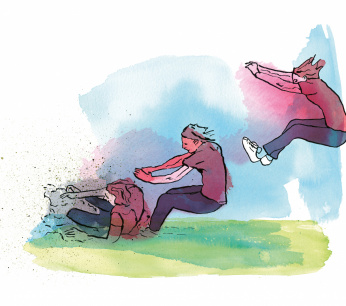Practical route promotes teaching among students
The Eligant Lyceum in Zutphen is one of nine pilot schools where students can opt for the HAVO Education practical route. Here they discover whether working in education is something for them.
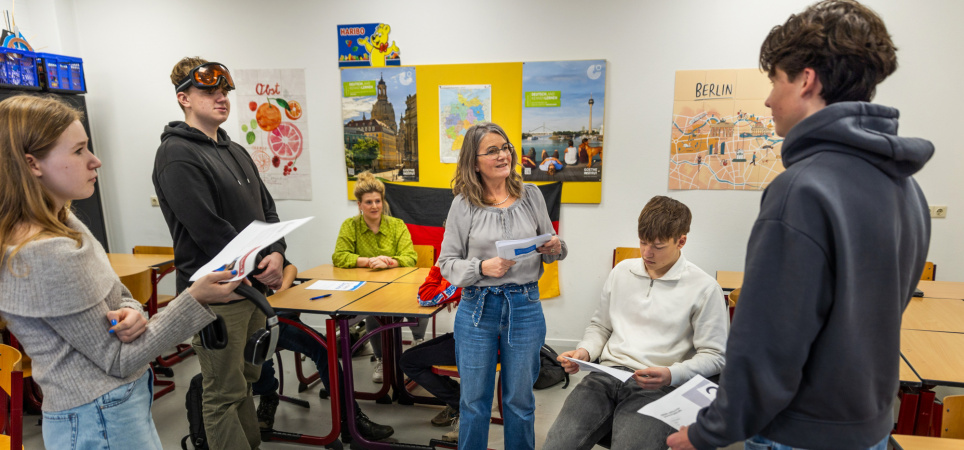
Students from the HAVO education practical route at the Eligant Lyceum in Zutphen play the role of children with a need for support. Coordinator Sandra Mors and Willeke Voskamp (seated) supervise the game. Image Herman Engbers.
“I feel left out,” says the 'disabled' boy in the office chair as he lags behind the rest. This Friday afternoon, students from the HAVO Education practical route at the Eligant Lyceum in Zutphen will do a role play in which they experience what it means to have a disability.
The fifteen students receive lessons every other week in which they are introduced to the field of education and education. The Eligant Lyceum is one of the nine pilot schools that have been offering the route since this school year. “We were immediately enthusiastic,” says teacher Willeke Voskamp. “As a training school, we work closely with the Arnhem and Nijmegen University of Applied Sciences and Radboud University, so this practical route fits in nicely with that.”
Sandra Mors, career development-oriented learning coordinator, adds: “Students go out to experience for themselves what the work entails. That suits the HAVO student who is mainly practical.”
Follow-up study
For example, students can work at a primary school, in a museum or in nature education. They receive lessons in didactics and pedagogy, conduct research, observe lessons and also teach themselves. “The goal is for students to make a well-founded choice for further education,” says Pascal Marsman of slo, the expertise center for the curriculum that supports the pilot schools. “In addition, students gain a mix of knowledge and generic skills that are necessary for all further studies, such as communicating, collaborating and presenting.”
We show how great it is to work in education
On behalf of the Ministry of Education, SLO developed the draft examination program together with two colleges and a number of secondary schools, including the Eligant Lyceum. In the pilot, which runs until 2026, schools determine the program of 120 study load hours themselves. “We try to show the entire field of work,” says Mors. The school involves the environment such as a museum, nature center or publishing house. Students attend further training courses, but also carry out assignments, such as making a schoolyard around the corner more sustainable. “We think it is important to show how great it is to work in education. And that it is so much broader than just teaching.”
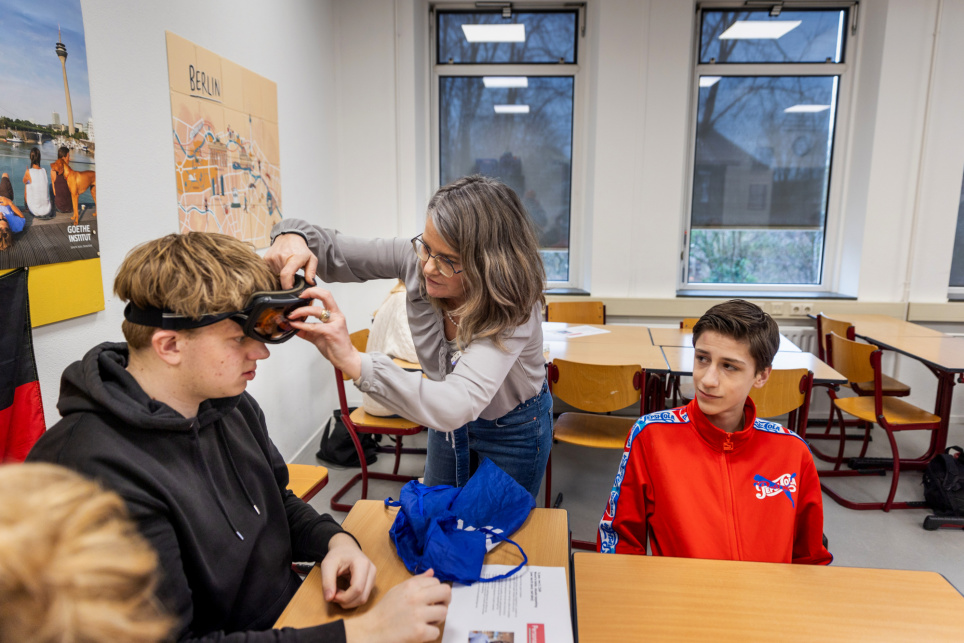
Sandra Mors, coordinator of career development-oriented learning at Eligant Lyceum, adapted a role play from the Expertise Center for Inclusive Education (ECIO) for use in HAVO. Image: Herman Engbers.
“Above all, the practical route is of course a great way to promote the teaching profession,” says Voskamp. Research by ResearchNed shows that good study choice guidance leads to more registrations for teacher training courses. “I teach German, I teach the classroom with a lot of passion and I enjoy getting students enthusiastic about the profession. This practical route allows them to really experience whether education is something for them, which will hopefully also reduce dropout from teacher training.” Mors: “Yes, because finding out that it is not something for you is just as valuable.”
Constraint
Sandra Mors is teaching today about inclusivity, in which a number of classmates play the role of a student with a need for support. “If I say: Good to see you, what does that do to you?” the teacher asks. “Nothing, because I can't hear,” jokes the girl with the headphones. “I like that; it is a compliment to me because you are happy that I am there,” answers the 'visually impaired' boy with ski goggles. The other participants agree with him, including the student 'without disability'. “Very nice, because this shows that everyone benefits from being seen,” says Mors, “something to take into account if you work as an educational professional.”
Finding out that it's not for you is just as valuable
Merle (16) is not yet sure whether she wants to go into education. “Maybe I want to become a teacher, but with small children. These lessons help me make a good choice, so that's nice.” Her friend Kris (17) agrees. “I'm thinking about doing pedagogy. We will visit various training courses, receive lessons in that direction and gain experience. We really have an advantage when we go to higher professional education.”
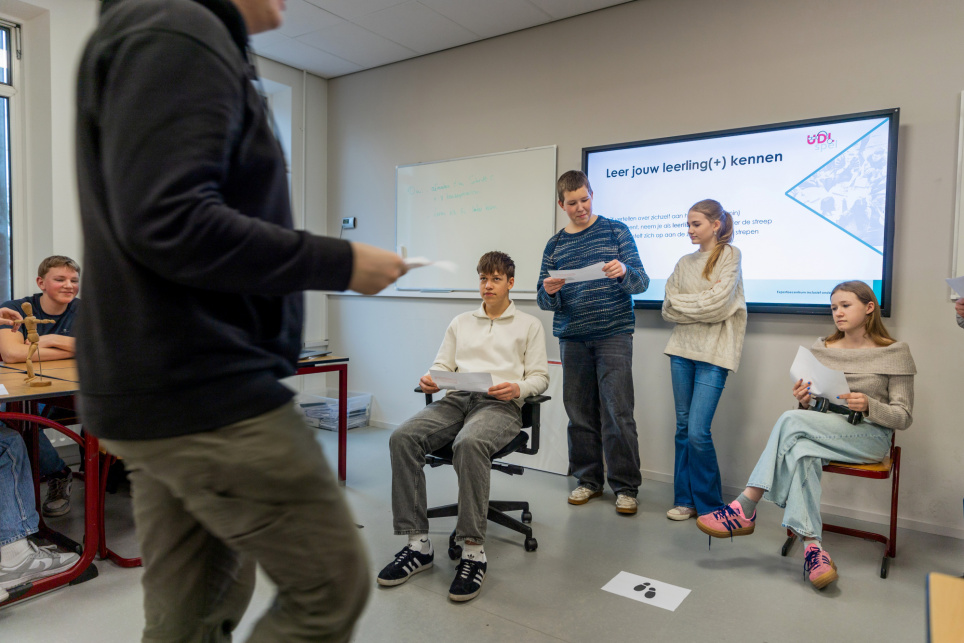
Fifteen students from the Eligant Lyceum receive lessons every other week in which they are introduced to the field of education and training. Image: Herman Engbers
In addition to these two HAVO students, the group also has six HAVO students. Although the practical route is in principle intended for upper havo, seven pre-university education students also participate at the Eligant Lyceum. “They were immediately enthusiastic and now we have a very nice, diverse group,” says Voskamp. “So far we have covered topics such as educational science, subject didactics and group dynamics in the lessons. They find everything involved in teaching very interesting.”
Completing the program takes time, but it also provides energy, says Mors. “It is so much fun to offer students a behind-the-scenes look at our work. There are so many possibilities, also in collaboration with the environment, that naturally makes you enthusiastic.”
Hot topic
For graduate students, this route is part of the combination grade and for pre-university education students it will be included on the plus document. The completion consists of a portfolio with three assignments: writing a response to an article, determining a vision on education and teaching a lesson. In addition, the aim is that students also write their profile paper on an educational subject. Mors: “Which makes it a masterpiece, just like at the Technasium. This just doesn't fit within the practical route in terms of hours, so we try to link it to another subject.” Voskamp: “For example, a study into German in primary school, which is a hot topic here.”
In addition, they would also have liked to offer the entrance tests for teacher training courses within the practical route. “But that turned out not to be the intention,” Mors explains. “It is purely about getting to know the professional field so that students can make a good study choice. Because we believe the tests have added value, we offer them to students who want them.”
Like Martijn (15), who is already sure that he wants to go to teacher training college. “I think it would be great fun to contribute to the development of children and to bond with them. I also had such a good teacher in group 8, who really paid attention to everyone. I have already done an internship at two primary schools. Children really appreciate that you help them, it was really fun.”
He sees the practical route as a good preparation for teacher training. “I find the lessons interesting. There is a good mix between theory and practice and I like that variety. I think it is very good that this practical route exists. There is a major shortage of teachers and hopefully this will lead to more people choosing education.”
Children want to become teachers again
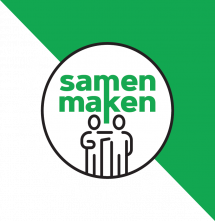
In the past, many children wanted to become teachers, but that is no longer so obvious. It is therefore surprising that a new generation of children puts the profession of teacher first, above YouTuber, influencer or doctor. Metro News writes this following large-scale research by Human1 in Belgium and the Netherlands into the generation of children born after 8: 'Generation Alpha'.
Why did you become a teacher or educational assistant and what makes work in education so attractive? The Onderwijsblad is investigating this and is curious about your story. Nearly 1000 people have already completed the survey. Also participate: aob.nl/wereldbaan and help increase interest in your profession.

